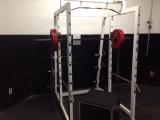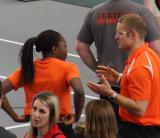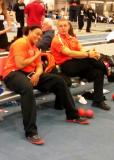Folders |
Throwing Between the Lines: Value in Training - March 27, 2013
Published by
By Ben Bishop
When Tom Kaberna and Mike Newman tell you that they would like you to start blogging about your event specialty, you don’t hesitate to fulfill that request. Both of these individuals have done an excellent job of improving our sport, and if I can somehow contribute in a similar fashion, this will certainly have been a success.
I was able to attend the USTFCCCA course this summer in Houston along with Tom and the rest of the Lake Park coaching staff (if you can attend, I highly recommend these courses, which is moving to Chicago this summer). It should be no mystery as to why these coaches continue to produce top athletes. They keep an open mind, continue to research, ask questions, record data, and make the necessary changes to improve. I hope that you are also willing to take this approach and continue to constantly evaluate your own program. It is this reason that I encourage you to ask questions within this writing. Starting the conversation will widen your own perspective and will help all of us continue to get better. Throwing is a business I’ve been involved with my entire life. I rose through the ranks in college, competed in multiple national meets, broke school, facility, and meet records, and have thrown every kind of implement. I still look back and think to myself, “Wow, I wish I would have known that when I was throwing!” This outlook is what drives me to share my knowledge with athletes and fellow coaches as to give them the tools that I wish I had utilized.
The coaches that I am in contact with the most and who continue to contribute heavily to my coaching philosophy:
My brother, Brian Bishop (2012 Olympic Trials, Discus), and his coach, Andy Kohkanovsky (University of Kansas) along with the legendary Bob Nihells (LPHS Boys Throws Coach and too many stellar athletes to list here), my former teammate and coach Scott Block (SIU-Edwardsville), as well as former SIUE throws coach, Dave Astrauskas (University of Wisconsin). It is also worth mentioning Don Babbitt (University of Georgia) for graciously and insightfully answering the many, many questions I annoyed him with this summer in Houston!
Now, just consider some of the essential components to a great throwing program: technical models, strength programming, peaking, psychology, competition strategies, and so on.
On any given day, you may be asked to move from the facility you thought you had reserved for practice, or perhaps you were forced indoors due to weather, have team pictures that day forcing practice to be cut short, etc. These situations may be unique to high school or junior high coaches, forcing them to be flexible yet efficient. You can create the most detailed practice plan and map out each session for the entire season, but you have got to be able to roll with the punches on occasion. To do this, you must keep the overall goal in mind. Therefore, when you are forced to change, the question becomes: What can I do, right now, to get the best value out of this practice?
In most cases, I would recommend the most valuable training tools for any thrower: quality throws or technical work. If you cannot throw, then implement quality drills. Certainly, situations are different, but this means that you, as the coach, are coaching your athletes during these drills, i. e., stressing the improvement of correct positions and debunking bad habits, as well as reinforcing how the athlete can relate the movements to an actual throw. Your athletes may leave practice without being tired or sore some days, and this is completely sensible. Take the necessary precautions to ensure that they are getting the best value out of their session.
Another scenario may be that you need to get your heavy lifting done on Monday, so you make the necessary adjustments such that that the timing of the heavy central nervous system load (Tom Kaberna does a great job of discussing the CNS as well as quality over quantity in his 2/28 post of Hitting the Board, which I completely agree with) is in-line with your program for the rest of the week. We will discuss lifting and CNS stress more in-depth in the next post.
Value should be the underlying theme in all aspects of training. Is what you’re doing in training the best thing for your athletes on any given day given the circumstances?
Next post: Lifting, CNS loading, training volume, and peak timing
|







